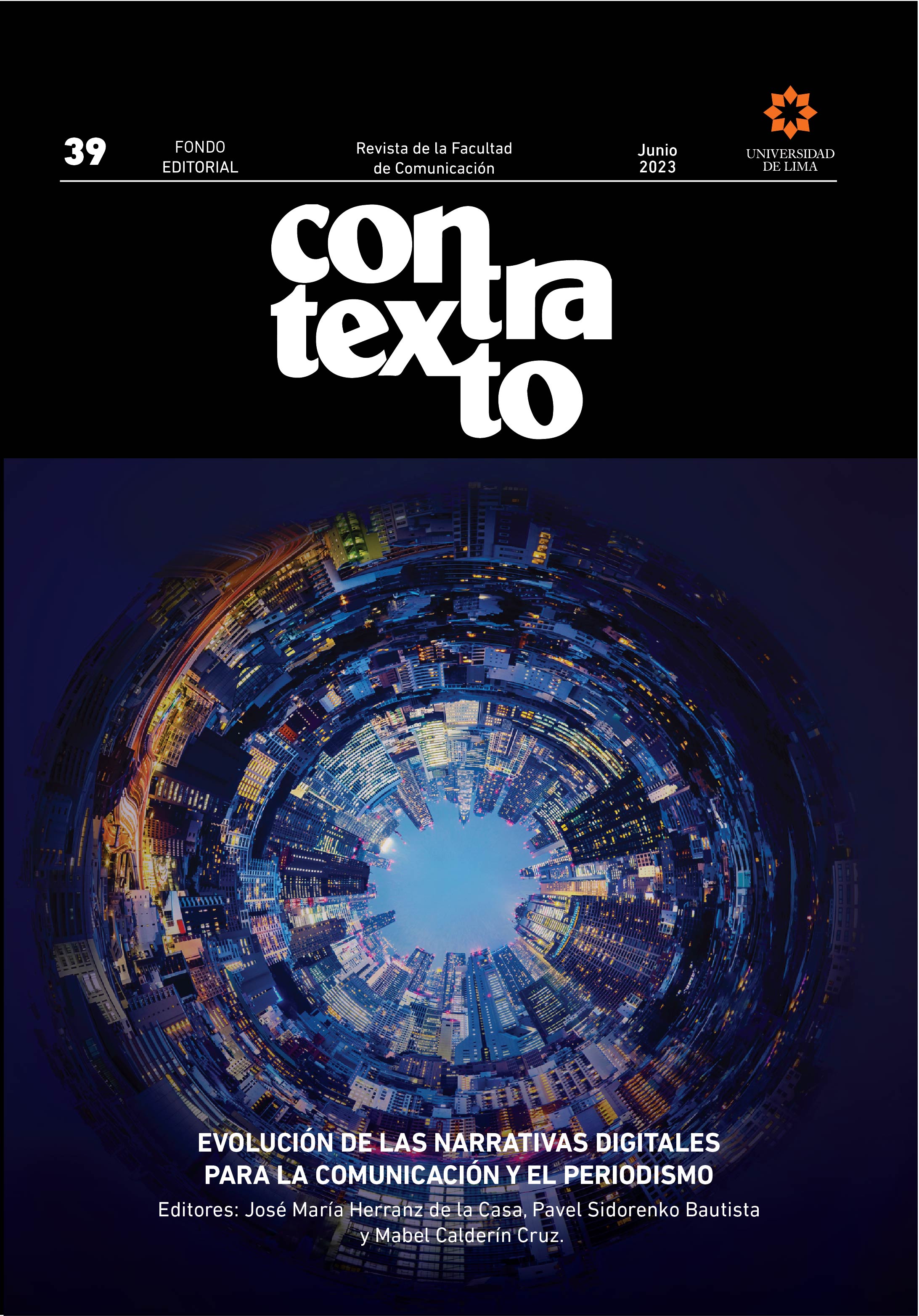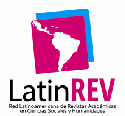Medicina complementaria y alternativa en Youtube: un estudio exploratorio de las comunidades de creadores de contenidos
DOI:
https://doi.org/10.26439/contratexto2023.n39.5723Palabras clave:
YouTube, creadores de contenidos, comunicación sanitaria, terapias alternativas, análisis visual de redesResumen
El objetivo de este artículo es explorar las comunidades generadas en YouTube por creadores de contenidos sobre medicina complementaria y alternativa (MCA). A través de la teoría de grafos, el análisis visual de redes y una amplia visión del contenido de los canales seleccionados se examinan las comunidades para evaluar su solidez como comunidad en función de su grado de conexión y densidad. Las comunidades fuertes están compuestas por individuos que difunden el mismo tema y punto de vista y que actúan como un solo bloque. Los resultados mostraron que los creadores de contenidos que promueven la MCA en YouTube tienen comunidades pequeñas y débiles; en cambio, los creadores de contenidos relacionados con la divulgación científica, que están en contra de la MCA, han construido comunidades fuertes.
Descargas
Referencias
Allgaier, J. (2019). Science and medicine on YouTube. In J. Hunsinger, M. M. Allen & L. Klastrup (Eds.), Second International Handbook of Internet Research (pp. 7-27). Springer; Dordrecht. https://doi.org/10.1007/978-94-024-1555-1_1
Amarasekara, I., & Grant, W. J. (2019). Exploring the YouTube science communication gender gap: a sentiment analysis. Public Understanding of Science, 28(1), 68-84. https://doi.org/10.1177/0963662518786654
Arthurs, J., Drakopoulou, S., & Gandini, A. (2018). Researching YouTube. Convergence, 24(1), 3-15. https://doi.org/10.1177/1354856517737222
Barabási, A. L. (2016). Network science. Cambridge University Press.
Barry, A. E., Muraleetharan, D., Nelon, J. L., Lautner, S. C., Callahan, M., Zhang, X., Herren, M., Chaney, B. H., & Stellfeson, M. (2018). Public perceptions of powdered alcohol use and misuse: narrative perspectives from YouTube. American Journal of Health Education, 49(4), 214-221, https://doi.org/10.1080/19325037.2018.1465865
Bärtl, M. (2018). YouTube channels, uploads and views: a statistical analysis of the past 10 years. Convergence, 24(1), 16-32. https://doi.org/10.1177/1354856517736979
Basch, C. H., Fung, I. C.-H., Hammond, R. N., Blankenship, E. B., Tse, Z. T. H., Fu, K.-W., Ip, P., & Basch, C. E. (2017). Zika virus on YouTube: an analysis of English-language video content by source. Journal of Preventive Medicine and Public Health, 50(2), 133-140. https://doi.org/10.3961/jpmph.16.107
Bastian, M., Heymann, S., & Jacomy M. (2009). Gephi: an open source software for exploring and manipulating networks. Proceedings of the International AAAI Conference on Web and Social Media, 3(1), 361-362. https://doi.org/10.1609/icwsm.v3i1.13937
Bertin, J. (1967). Sémiologie graphique. Les diagrammes, Les réseaux, Les cartes. Paris-La Haye; Mouton & Co.; Paris; Gauthier-Villars.
Bortoliero, S. T., & León, B. (2017). El rigor científico en el vídeo online. La percepción de los expertos sobre los vídeos de contaminación del aire en Youtube. Observatorio (OBS*), 11(3), 103-119. https://doi.org/10.15847/obsobs1132017925
Briones, R., Nan, X., Madden, K., & Waks, L. (2012). When vaccines go viral: an analysis of HPV vaccine coverage on YouTube. Health Communication, 27(5), 478-485. https://doi.org/10.1080/10410236.2011.610258
Brosnan, C. (2015). ‘Quackery’ in the academy? Professional knowledge, autonomy and the debate over complementary medicine degrees. Sociology, 49(6), 1047-1064. https://doi.org/10.1177/0038038514557912
Caldwell, E. F. (2017). Quackademia? Mass-Media delegitimation of homeopathy education. Science as Culture, 26(3), 380-407. https://doi.org/10.1080/09505431.2017.1316253
Cano-Orón, L. (2019). A Twitter campaign against pseudoscience: the sceptical discourse on complementary therapies in Spain. Public Understanding of Science, 28(6), 679-695. https://doi.org/10.1177/0963662519853228
Cano-Orón, L., & Lopera-Pareja, E. H. (2021). Media and science policy: Who influences whom regarding complementary and alternative medicines regulation. The International Journal of Press/Politics. https://doi.org/10.1177/19401612211047587
Cano-Orón, L., Mendoza-Poudereux, I., & Moreno-Castro, C. (2019). Perfil sociodemográfico del usuario de la homeopatía en España. Atención Primaria, 51(8), 499-505. https://doi.org/10.1016/j.aprim.2018.07.006
Caulfield, T., Marcon, A. R., Murdoch, B., Brown, J. M., Perrault, S. T., Jarry, J., Snyder, J., Anthony, S. J., Brooks, S., Master, Z., Rachul, C., Ogbogu, U., Greenberg, J., Zarzeczny, A., & Hyde-Lay, R. (2019). Health misinformation and the power of narrative messaging in the public sphere. Canadian Journal of Bioethics / Revue Canadienne de Bioéthique, 2(2), 52-60. https://doi.org/10.7202/1060911ar
Chatfield, K., Partington, H., & Duckworth, J. (2012). The place of the university in the provision of CAM education. Aust J Homeopathic Med, 24(1), 16-20. https://www.researchgate.net/publication/233747257_The_Place_of_the_University_in_the_Provision_of_CAM_Education
Coleman, J. S. (1988). Social capital in the creation of human capital. American Journal of Sociology, 94, S95-S120. https://doi.org/10.1086/228943
Corell-Doménech, M. (2019). Terapeutas alternativos en México y la estrategia de la OMS sobre medicina tradicional 2014-2023: comunicación, creencias y factores socio-económicos. Perspectivas de la Comunicación, 12(1), 59-77. https://doi.org/10.4067/s0718-48672019000100059
Daabes, A. S. A., & Kharbat, F. F. (2019). A content analysis of Arabic YouTube videos forcancer treatment. International Journal of Health Governance, 24(4), 267-273. https://doi.org/10.1108/ijhg-05-2019-0035
Decuypere, M. (2020). Visual network analysis: a qualitative method for researching sociomaterial practice. Qualitative Research, 20(1), 73-90. https://doi.org/10.1177/1468794118816613
Donzelli, G., Palomba, G., Federigi, I., Aquino, F., Cioni, L., Verani, M., Carducci, A., & Lopalco, P. (2018). Misinformation on vaccination: a quantitative analysis of YouTube videos. Human Vaccines & Immunotherapeutics, 14(7), 1654-1659. https://doi.org/10.1080/21645515.2018.1454572
Evans, M., Shaw, A., Thompson, E. A., Falk, S., Turton, P., Thompson, T., & Sharp, D. (2007). Decisions to use complementary and alternative medicine (CAM) by male cancer patients: information-seeking roles and types of evidence used. BMC Complementary and Alternative Medicine, 7(1), 25. https://doi.org/10.1186/1472-6882-7-25
Falkenberg, T., Lewith, G., Roberti di Sarsina, P., von Ammon, K., Santos-Rey, K., Hök, J., Frei-Erb, M., Vas, J., Saller, R., & Uehleke, B. (2012). Towards a pan-European definition of complementary and alternative medicine - a realistic ambition?” Forschende Komplementärmedizin / Complementary Medicine Research, 19(Suppl. 2), 6-8. https://doi.org/10.1159/000343812
Farley, T. (2009). Skepticism via YouTube. Skeptical Inquirer, 33(6). https://skepticalinquirer.org/2009/11/skepticism-via-youtube/
Fishman, J. M., & Casarett, D. (2006). Mass media and medicine: when the most trusted media mislead. Mayo Clinic Proceedings, 81(3), 291-293. https://doi.org/10.4065/81.3.291
Fu, S., Wang, Y., Yang, Y., Bi, Q., Guo, F., & Qu, H. (2018). VisForum: a visual analysis system for exploring user groups in online forums. ACM Transactions on Interactive Intelligent Systems (TiiS), 8(1), 1-21. https://doi.org/10.1145/3162075
Gale, N. (2014). The sociology of traditional, complementary and alternative medicine. Sociology Compass, 8(6), 805-822. https://doi.org/10.1111/soc4.12182
Garrett, B., Caulfield, T., Murdoch, B., Brignall, M. S., Kapur, A. K., Murphy, S. K., Nelson, E., Reardon, J., Harrison, M., Hislop, J., Wilson-Keates, B., Anthony, J. H., Loewen, P. C., Musoke, R., & Braun, J. (2022). A taxonomy of risk-associated alternative health practices: a Delphi study. Health & Social Care in the Community, 30(3), 1163-1181. https://doi.org/10.1111/hsc.13386
Granovetter, M. S. (1977). The strength of weak ties. Social Networks, 78, 347-367. Academic Press. https://doi.org/10.1016/B978-0-12-442450-0.50025-0
Hornik, R., Parvanta, S., Mello, S., Freres, D., Kelly, B., & Schwartz, J. S. (2013). Effects of scanning (routine health information exposure) on cancer screening and prevention behaviors in the general population. Journal of Health Communication, 18(12), 1422-1435. https://doi.org/10.1080/10810730.2013.798381
Idoyaga Molina, A. (2005). Reflexiones sobre la clasificación de medicinas. Análisis de una propuesta conceptual. Scripta Ethnologica, 27, 111-147. https://www.redalyc.org/pdf/148/14811516007.pdf
Instituto Cervantes. (2019). El español: una lengua viva. Informe 2019. https://www.cervantes.es/imagenes/File/espanol_lengua_viva_2019.pdf
Kelly-Hedrick, M., Grunberg, P. H., Brochu, F., & Zelkowitz, P. (2018). It’s totally okay to be sad, but never lose hope: content analysis of infertility-related videos on YouTube in relation to viewer preferences. Journal of Medical Internet Research, 20(5). https://doi.org/10.2196/10199
Kettell, S. (2014). Divided we stand: the politics of the atheist movement in the United States. Journal of Contemporary Religion, 29(3), 377-391. https://doi.org/10.1080/13537903.2014.945722
Lopera-Pareja, E. H., & Cano-Orón, L. (2021). Media’s portrayal of CAM: Exploring 40 years of narratives and meanings in public discourse. Journalism, 23(10), 2171-2191. https://doi.org/10.1177/1464884920985407
Madathil, K. C., Rivera-Rodriguez, A. J., Greenstein, J. S., & Gramopadhye, A. K. (2015). Healthcare information on YouTube: A systematic review. Health Informatics journal, 21(3), 173-194. https://doi.org/10.1177/1460458213512220
Marcon, A. R., & Caulfield, T. (2017). Commenting on chiropractic: a YouTube analysis. Cogent Medicine, 4(1). https://doi.org/10.1080/2331205x.2016.1277450
Moody, J., & White, D. R. (2003). Structural cohesion and embeddedness: a hierarchical concept of social groups. American Sociological Review, 68(1), 103-127. https://doi.org/10.2307/3088904
Pérez, C., Sepúlveda, D., Cova, F., & Nazar, G. (2020). Salud intercultural desde la visión de las comunidades mapuche de Cañete y Tirúa. Revista Ciencias de la Salud, 18(1), 152-168. https://doi.org/10.12804/revistas.urosario.edu.co/revsalud/a.8778
Pithadia, D. J., Reynolds, K. A., Lee, E. B., & Wu, J. J. (2019). A cross-sectional study of YouTube videos as a source of patient information about topical psoriasis therapies. Journal of Dermatological Treatment, 31(4), 366-369. https://doi.org/10.1080/09546634.2019.1597247
Reddy, K., Kearns, M., Álvarez-Arango, S., Carrillo Martín, I., Cuervo-Pardo, N., CuervoPardo, L., Dimov, V., Lang, D., López-Álvarez, S., Schroer, B., Mohan, K., Dula, M., Zheng, S., Kozinetz, C., & González-Estrada, A. (2018). YouTube and food allergy: an appraisal of the educational quality of information. Pediatric Allergy and Immunology, 29(4), 410-416. https://doi.org/10.1111/pai.12885
Rieder, B. (2017, December 5). YouTube data tools (Version 1.08) [Software]. https://tools.digitalmethods.net/netvizz/youtube/
Ruppert, L., Køster, B., Siegert, A. M., Cop, C., Boyers, L., Karimkhani, C., Winston, H., Mounessa, J., Dellavalle, R. P., Reinau, D., Diepgen, T., & Surber, C. (2017). YouTube as a source of health information: analysis of sun protection and skin cancer prevention related issues. Dermatology Online Journal, 23(1). https://doi.org/10.5070/d3231033669
Smith, C., & Cimino, R. (2015). The creation of secularist space on the Internet. In S. Brunn (Ed.), The changing world religion map (pp. 3733-3749). Springer; Dordrecht. https://doi.org/10.1007/978-94-017-9376-6_196
Smith, J. M., & Payne, H. J. (2017). Social capital.The International Encyclopedia of Organizational Communication. Wiley Online Library. https://doi.org/10.1002/9781118955567.wbieoc189
Tabassum, S., Pereira, F. S. F., Fernandes, S., & Gama, J. (2018). Social network analysis: an overview. WIREs Data Mining and Knowledge Discovery, 8(5). https://doi.org/10.1002/widm.1256
Torres, I., & Trinidad, J. C. (2015). Analysis of the YouTube channel recommendation network. CS 224W Project Milestone. https://snap.stanford.edu/class/cs224w2015/projects_2015/Analysis_of_the_YouTube_Channel_Recommendation_Network.pdf
Tulin, M., Pollet, T. V., & Lehmann-Willenbrock, N. (2018). Perceived group cohesion versus actual social structure: a study using social network analysis of egocentric Facebook networks. Social Science Research, 74, 161-175. https://doi.org/10.1016/j.ssresearch.2018.04.004
Varshney, D., & Vishwakarma, D. K. (2021). A unified approach for detection of Clickbait videos on YouTube using cognitive evidences. Applied Intelligence, 51(7), 4214-4235. https://doi.org/10.1007/s10489-020-02057-9
Vaterlaus, J. M., Patten, E. V., Roche, C., & Young, J. A. (2015). #Gettinghealthy: the perceived influence of social media on young adult health behaviors. Computers in Human Behavior, 45, 151-157. https://doi.org/10.1016/j.chb.2014.12.013
Venkatraman, A., Garg, N., & Kumar, N. (2015). Greater freedom of speech on Web 2.0 correlates with dominance of views linking vaccines to autism. Vaccine, 33, 1422-1425. https://doi.org/10.1016/j.vaccine.2015.01.078
Venturini, T., Jacomy, M., & Carvalho Pereira, D. (2015). Visual network analysis. https://www.researchgate.net/publication/278030230_Visual_Network_Analysis
Venturini, T., Jacomy, M., & Jensen, P. (2019). What do we see when we look at networks. An introduction to visual network analysis and force-directed layouts. Social Science Research Network. https://doi.org/10.2139/ssrn.3378438
Weeks, L. C., & Strudsholm, T. (2008). A scoping review of research on complementary and alternative medicine (CAM) and the mass media: looking back, moving forward. BMC Complementary and Alternative Medicine, 8(1). https://doi.org/10.1186/1472-6882-8-43
Wieland, L. S., Manheimer, E., & Berman, B. M. (2011). Development and classification of an operational definition of complementary and alternative medicine for the Cochrane collaboration. Alternative therapies in health and medicine, 17(2), 50-59. https://www.ncbi.nlm.nih.gov/pmc/articles/PMC3196853/
World Health Organization (2013). WHO traditional medicine strategy: 2014-2023. https://apps.who.int/iris/handle/10665/92455
Yang, Q., Sangalang, A., Rooney, M., Maloney, E. K., Emery, S., & Cappella, J. N. (2018). How is marijuana vaping portrayed on YouTube? Content, features, popularity and retransmission of vaping marijuana YouTube videos. Journal of Health Communication, 23(4), 360-369. https://doi.org/10.1080/10810730.2018.1448488
Yin, J., Basch, C. H., Adnan, M. M., Fullwood, M. D., Menafro, A., & Fung, I. C. (2018). Attributes of videos on YouTube related to cupping therapy. Alternative Therapies in Health and Medicine, 24(6), 32-37. http://www.alternative-therapies.com/index.cfm/fuseaction/archives.main&mode=issue&issueid=7391
YouTube Help (2020, April 19). Youtube channel monetization policies. https://support.google.com/youtube/answer/1311392?hl=en
Zannettou, S., Chatzis, S., Papadamou, K., & Sirivianos, M. (2018). The good, the bad and the bait: detecting and characterizing clickbait on YouTube. 2018 IEEE Security and Privacy Workshops (SPW), 63-69. https://doi.org/10.1109/spw.2018.00018
Descargas
Publicado
Número
Sección
Licencia
Todos los trabajos publicados están sujetos a una licencia CC BY 4.0 Creative Commons (actualizado el 1 de marzo de 2021).
El contenido de la revista se puede compartir en cualquier material o formato. Asimismo, se puede adaptar, contribuir y transformar. Ambas posibilidades sólo están permitidas en la medida en que cumplan las siguientes condiciones:
- Atribución: Se debe otorgar crédito donde sea debido, proporcionar un enlace a la licencia e indicar los cambios en caso se realice alguno. Esto debe hacerse de la manera que se considere apropiada, sin sugerir que el licenciante lo promueva a usted o su uso del material.
Derechos de propiedad
Los derechos patrimoniales de Contratexto se publican bajo una licencia Creative Commons BY 4.0, lo que permite a los autores mantener los derechos patrimoniales de su obra sin restricciones.
Si un trabajo publicado en Contratexto fuera copiado, distribuido, difundido o cualquier otra actividad contemplada en la licencia antes mencionada, se deberá mencionar de manera visible y expresa al autor o autores y a la revista.
Auto-archivo
Esta revista permite y anima a los autores/as a publicar artículos enviados a la revista en sus sitios web personales o en depósitos institucionales, tanto antes como después de su publicación en esta revista, siempre y cuando proporcionen información bibliográfica que acredite, si procede, su publicación en ella.


















